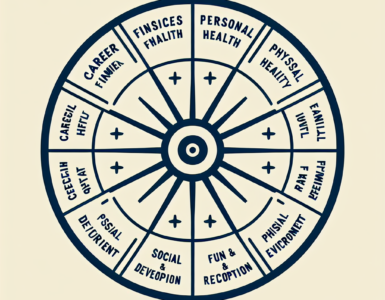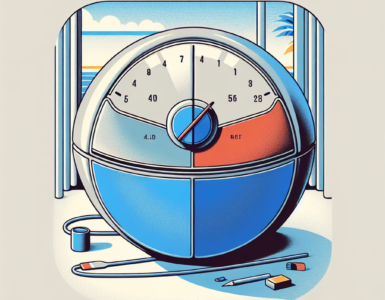Introduction to Circadian Rhythms
Understanding circadian rhythms is crucial for high-performing individuals aiming to synchronize their work habits with their biological clocks for enhanced productivity.
What Is the Circadian Rhythm Sleep-Wake Cycle?
The circadian rhythm sleep-wake cycle refers to the internal clock that regulates the timing of sleepiness and wakefulness over a 24-hour period. Governed by the brain’s hypothalamus, this cycle is influenced by external cues like light and darkness, dictating when one should be alert and when one should rest. Adhering to this cycle can significantly impact an individual’s energy levels and productivity throughout the day.
The Science Behind Circadian Rhythms
Circadian rhythms are driven by a group of interacting molecules within cells throughout the body. A “master clock” in the brain coordinates all the body clocks so that they are in sync. This master clock is directly influenced by environmental cues, especially light, which is why circadian rhythms are tied to the cycle of day and night.
| Biological Process | Typical Peak Time (24-hour clock) |
|---|---|
| Alertness | 10:00 – 14:00 |
| Coordination | 14:30 – 17:30 |
| Reaction Time | 15:30 – 18:00 |
| Cardiovascular Efficiency and Muscle Strength | 17:00 – 19:00 |
| Melatonin Secretion Begins | 21:00 – 22:00 |
| Deepest Sleep | 02:00 – 04:00 |
| Body Temperature Rise | 04:30 – 06:30 |
When the circadian rhythm sleep-wake cycle is aligned with an individual’s schedule, they can leverage their natural fluctuations in energy and alertness to optimize their performance in various tasks.
The Impact of Circadian Rhythms on Productivity
Circadian rhythms, the internal body clock that regulates the sleep-wake cycle, profoundly influence an individual’s productivity throughout the day. Understanding these rhythms can help high-performing individuals optimize their schedules for maximum efficiency.
Peak Performance Times
Research indicates that most individuals experience their peak cognitive performance in late morning hours. This period is typically characterized by heightened alertness and better concentration. Conversely, the early afternoon often sees a dip in performance, commonly known as the ‘afternoon slump.’
| Time of Day | Performance Level |
|---|---|
| Early Morning | Warm-up Phase |
| Late Morning | Peak Cognitive Performance |
| Early Afternoon | Afternoon Slump |
| Late Afternoon | Recovery Phase |
| Evening | Second Peak for Some Individuals |
It’s important for individuals to recognize these patterns and schedule their most demanding cognitive tasks during their personal peak times, which may slightly vary from the general trend.
The Effects of Disrupted Circadian Rhythms
Disruptions to the circadian rhythm sleep-wake cycle can lead to a decline in productivity. Factors such as irregular sleep patterns, exposure to light at night, and high-stress levels can throw off the circadian rhythm, leading to daytime sleepiness, impaired cognitive function, and decreased motivation.
Chronic misalignment, such as that experienced by shift workers or those with irregular schedules, can have long-term consequences on productivity. It is linked to various health issues, including sleep disorders, metabolic syndrome, and mood disturbances, all of which can affect an individual’s ability to perform optimally.
| Disruption Source | Potential Impact |
|---|---|
| Irregular Sleep Patterns | Decreased Alertness |
| Light Exposure at Night | Impaired Cognitive Function |
| High Stress Levels | Reduced Motivation |
Individuals are encouraged to adhere to regular sleep schedules and manage environmental factors to minimize the adverse effects on their circadian rhythms and maintain productivity.
Aligning Your Schedule with Your Circadian Rhythm
Maximizing productivity may be influenced by understanding and aligning with one’s circadian rhythm sleep-wake cycle. The synchronization of daily activities with individual biological clocks can enhance performance and well-being.
Identifying Your Personal Circadian Rhythm
Identifying one’s personal circadian rhythm involves observing the body’s natural tendencies for sleepiness and alertness throughout the day. By recognizing these patterns, individuals can schedule tasks to match their peak performance times.
One method to determine personal circadian rhythm is keeping a sleep diary. This involves recording sleep times, wake times, and energy levels at various points during the day over a period of weeks. Another approach is to note periods of high concentration and when fatigue typically sets in.
| Time of Day | Energy Level | Focus Level | Recommended Activity |
|---|---|---|---|
| Early Morning | High/Medium | High | Analytical tasks |
| Late Morning | Medium | Medium | Administrative tasks |
| Afternoon | Variable | Low | Creative brainstorming |
| Evening | Low/Variable | Low | Leisure activities |
Structuring Your Day for Optimal Productivity
Structuring the day around personal circadian rhythms can boost productivity by aligning work tasks with natural energy fluctuations. It is suggested to tackle the most demanding cognitive tasks during one’s peak alertness times, often in the morning.
Midday, when energy levels can dip, may be more suitable for less demanding tasks or those that require less concentration. The afternoon, often associated with a slump in alertness, might be better for collaborative and creative work that can benefit from a more relaxed mind.
| Task Type | Ideal Time Based on Circadian Rhythm |
|---|---|
| Complex problem-solving | Peak alertness period (e.g., late morning) |
| Routine emails and administrative tasks | When alertness begins to wane (e.g., midday) |
| Meetings and collaboration | Early afternoon (post-lunch period) |
| Creative work | Late afternoon to early evening |
By aligning tasks with these energy patterns, individuals can work more effectively, potentially leading to enhanced performance and overall job satisfaction. It is crucial, however, to be flexible and adjust schedules as necessary to accommodate variations in daily energy levels and unforeseen demands.
Circadian Rhythms and Work Habits
Understanding one’s circadian rhythm sleep-wake cycle can be pivotal in optimizing work habits for enhanced productivity. By aligning tasks with the natural body clock, individuals can leverage peak performance times throughout the day.
The Best Times for Cognitive Tasks
Cognitive tasks require high levels of concentration, analytical thinking, and decision-making. Research indicates that for most individuals, these tasks are best performed during the late morning hours.
| Time of Day | Cognitive Task Suitability |
|---|---|
| Early Morning | Moderate |
| Late Morning | High |
| Afternoon | Low to Moderate |
| Evening | Low |
The late morning hours typically follow the peak in cortisol levels, which helps promote alertness and mental clarity. Scheduling tasks such as critical analysis, complex problem-solving, and strategic planning during this period can result in more efficient and effective work output.
The Best Times for Physical Tasks
Physical tasks, which may include manual labor, exercise, or any work requiring physical exertion, can also benefit from alignment with the circadian rhythm. There is a natural peak in body temperature and cardiovascular efficiency in the late afternoon, making it an ideal time for engaging in physical tasks.
| Time of Day | Physical Task Suitability |
|---|---|
| Morning | Low to Moderate |
| Afternoon | High |
| Early Evening | High |
| Late Evening | Moderate |
By scheduling physically demanding tasks such as workouts, manual labor, or hands-on projects during the late afternoon or early evening, individuals can take advantage of their body’s natural state of readiness for physical exertion.
The Best Times for Creative Tasks
Creative tasks often require a different approach to thinking, one that is less structured and more free-flowing. Interestingly, creativity can flourish during times when the brain is not at its peak alertness level.
| Time of Day | Creative Task Suitability |
|---|---|
| Morning | Moderate |
| Late Morning | Moderate |
| Afternoon | High |
| Evening | High |
For many individuals, the afternoon, when alertness may begin to wane, can be an opportune time to engage in creative endeavors such as brainstorming, artistic expression, or innovative problem-solving. This time period can encourage divergent thinking, allowing for the exploration of novel ideas and perspectives.
By recognizing and respecting the circadian rhythm sleep-wake cycle, high-performing individuals can tailor their work habits to align with their biological clocks. This alignment can enhance cognitive function, physical performance, and creativity, ultimately leading to greater productivity and success in their professional lives.
Tips for Maintaining a Healthy Circadian Rhythm
Maintaining a healthy circadian rhythm is essential for individuals aiming to enhance their productivity and energy management. There are several strategies one can employ to ensure their circadian rhythm sleep-wake cycle is optimized for peak performance.
Exposure to Natural Light
One of the most effective ways to regulate the circadian rhythm sleep-wake cycle is through exposure to natural light. Light is the primary cue that signals the body’s internal clock, influencing sleep patterns and alertness. To synchronize the circadian rhythm with the natural environment, individuals should seek to expose themselves to bright light, particularly in the morning.
| Time of Day | Light Exposure Recommendation |
|---|---|
| Morning | At least 30 minutes of natural light |
| Afternoon | Moderate exposure during work breaks |
| Evening | Diminished light to prepare for rest |
Consistent Sleep Patterns
Consistent sleep patterns are a cornerstone of maintaining a healthy circadian rhythm. Going to bed and waking up at the same time every day, even on weekends, reinforces the body’s sleep-wake cycle and can improve sleep quality over time.
| Sleep Aspect | Suggested Practice |
|---|---|
| Bedtime | Fixed time each night |
| Wake Time | Consistent morning wake-up time |
| Sleep Duration | 7-9 hours (as recommended for adults) |
Managing Technology and Screen Time
The blue light emitted by screens can interfere with the circadian rhythm sleep-wake cycle by suppressing the production of melatonin, the hormone responsible for regulating sleep. Managing technology and screen time, especially before bed, is crucial for maintaining a healthy cycle.
| Activity | Recommendation |
|---|---|
| Screen Time Before Bed | Limit use 1-2 hours before sleep |
| Use of Blue Light Filters | Enable on devices during evening hours |
| Technology-Free Zone | Keep bedroom free of disruptive devices |
By incorporating these tips into daily routines, high-performing individuals can maintain a healthy circadian rhythm sleep-wake cycle, which is instrumental in achieving optimal productivity and performance. Whether one is an entrepreneur, athlete, or creative professional, aligning work habits with biological clocks can lead to significant improvements in both personal and professional life.
Challenges and Solutions
The circadian rhythm sleep-wake cycle plays a pivotal role in dictating an individual’s energy levels and productivity throughout the day. However, certain lifestyle factors can pose challenges to maintaining a consistent cycle. This section explores some common difficulties and provides potential solutions to help individuals navigate these issues.
Shift Work and Irregular Hours
Shift work and irregular hours can significantly disrupt the natural circadian rhythm, leading to a mismatch between an individual’s internal clock and their work schedule. This can result in decreased alertness and performance during work hours.
| Challenge | Potential Solution |
|---|---|
| Inconsistent sleep schedule | Aim for regularity in sleep times, even on days off |
| Reduced exposure to natural light | Seek bright light exposure during waking hours, especially in the morning |
| Difficulty sleeping during the day | Create a dark, quiet sleep environment with blackout curtains and earplugs |
Individuals working irregular hours may need to be proactive in creating an environment that supports their unique sleep-wake needs. Employers can also assist by offering flexible scheduling or rotating shifts in a clockwise manner to align more closely with the natural progression of the circadian rhythm.
Travel and Time Zone Changes
Traveling across time zones can lead to jet lag, a temporary disruption in the circadian rhythm caused by rapid long-distance travel. This can impair cognitive function and reduce overall productivity.
| Time Zone Change | Adjustment Strategy |
|---|---|
| 1-2 hours | Expose yourself to daylight at your destination to reset your internal clock |
| 3+ hours | Gradually adjust your sleep schedule before travel |
| Multiple time zones | Consider using short naps to mitigate fatigue |
For frequent travelers, it’s beneficial to align their activities to the local time as soon as possible. Hydration and avoidance of heavy meals close to bedtime can also aid in adjusting to new time zones.
Individual Variations and Flexibility
Every individual has a unique circadian rhythm that may not align perfectly with the typical 9-to-5 work schedule. Recognizing one’s personal peak performance times can lead to a more effective workday.
| Circadian Preference | Suggested Work Schedule |
|---|---|
| Morning type (early riser) | Tackle priority tasks in the morning |
| Evening type (night owl) | Reserve complex tasks for later in the day |
For those with the flexibility to set their own hours, structuring the workday around their natural energy peaks can enhance productivity. Employers can also support circadian health by offering flexible work hours and encouraging breaks during slumps in energy levels.
In conclusion, managing the challenges posed by shift work, travel, and individual variations requires both personal strategies and supportive workplace policies. By understanding and adapting to these circadian rhythm sleep-wake cycle challenges, individuals and organizations can foster an environment conducive to optimal productivity and well-being.
Enhancing Productivity Through Circadian Science
Understanding and leveraging the circadian rhythm sleep-wake cycle can greatly enhance productivity and overall well-being. By making strategic adjustments in the workplace and adopting personal energy management strategies, one can align their daily activities with their biological clock. Diet and exercise also play pivotal roles in maintaining a healthy circadian rhythm.
Workplace Adjustments for Circadian Health
Workplaces can implement several strategies to support the circadian health of their employees. These adjustments not only contribute to the well-being of individuals but can also enhance collective productivity and job satisfaction.
-
Optimize Lighting: Work areas with natural light exposure can help reinforce the body’s natural circadian rhythm. For spaces without access to natural light, installing lighting systems that mimic daylight patterns can be beneficial.
-
Flexible Work Hours: Allowing for flex-time or staggered work hours can enable employees to work during their peak performance periods, as determined by their individual circadian rhythms.
-
Break and Rest Areas: Encouraging regular breaks and providing rest areas can help employees recharge during natural dips in their circadian cycle.
| Strategy | Description | Implementation |
|---|---|---|
| Natural Lighting | Exposure to daylight | Install large windows, use skylights |
| Artificial Circadian Lighting | Mimic daylight patterns | Use LED lights that change color temperature |
| Flexible Hours | Work during peak alertness | Offer flexible scheduling options |
| Rest Areas | Spaces for relaxation | Create quiet zones with comfortable seating |
Personal Strategies for Energy Management
Individuals can take personal steps to align their schedules with their circadian rhythm for better energy management.
-
Track Personal Energy Levels: Monitoring one’s own energy patterns throughout the day can help identify peak productivity times.
-
Schedule Tasks Accordingly: Plan to tackle the most demanding cognitive tasks during periods of high alertness and save less demanding activities for when energy levels wane.
-
Regular Breaks: Incorporate short, frequent breaks to maintain focus and avoid burnout.
| Time of Day | Energy Level | Suggested Activity |
|---|---|---|
| Morning | High | Complex problem-solving, decision-making |
| Early Afternoon | Moderate | Administrative tasks, meetings |
| Late Afternoon | Lower | Creative brainstorming, light physical activity |
The Role of Diet and Exercise in Circadian Rhythm
Diet and exercise are critical components of circadian health, influencing sleep quality and energy levels.
-
Meal Timing: Aligning meal times with the circadian cycle can optimize digestion and energy utilization.
-
Food Choices: Consuming a balanced diet with an emphasis on whole foods can support sustained energy throughout the day.
-
Regular Exercise: Engaging in regular physical activity, particularly in the morning, can help reinforce the body’s natural sleep-wake cycle.
| Factor | Role in Circadian Health | Recommendations |
|---|---|---|
| Meal Timing | Synchronizes eating patterns with internal clock | Eat meals at consistent times daily |
| Food Choices | Affects energy and sleep quality | Choose nutrient-rich foods, avoid heavy meals close to bedtime |
| Exercise | Promotes better sleep and alertness | Engage in moderate exercise, preferably in daylight hours |
By making informed adjustments in the workplace, adopting personal strategies for energy management, and understanding the influence of diet and exercise, individuals can harness the power of their circadian rhythm sleep-wake cycle to maximize productivity and maintain a healthy, balanced lifestyle.











